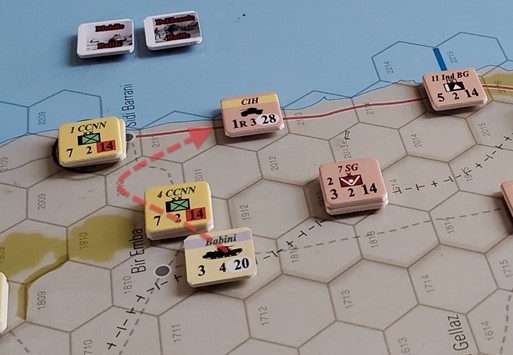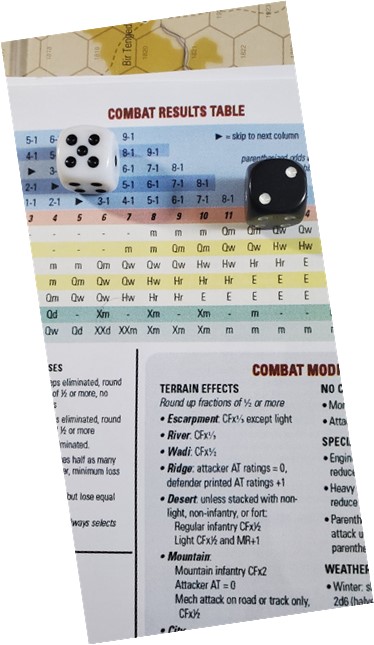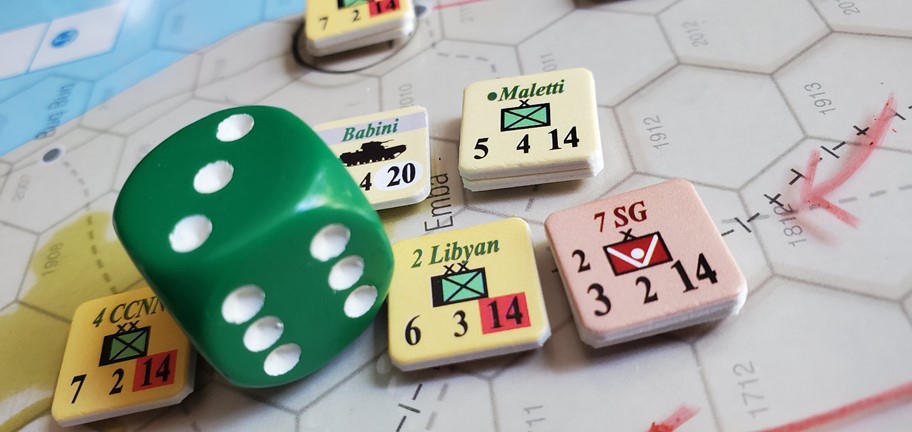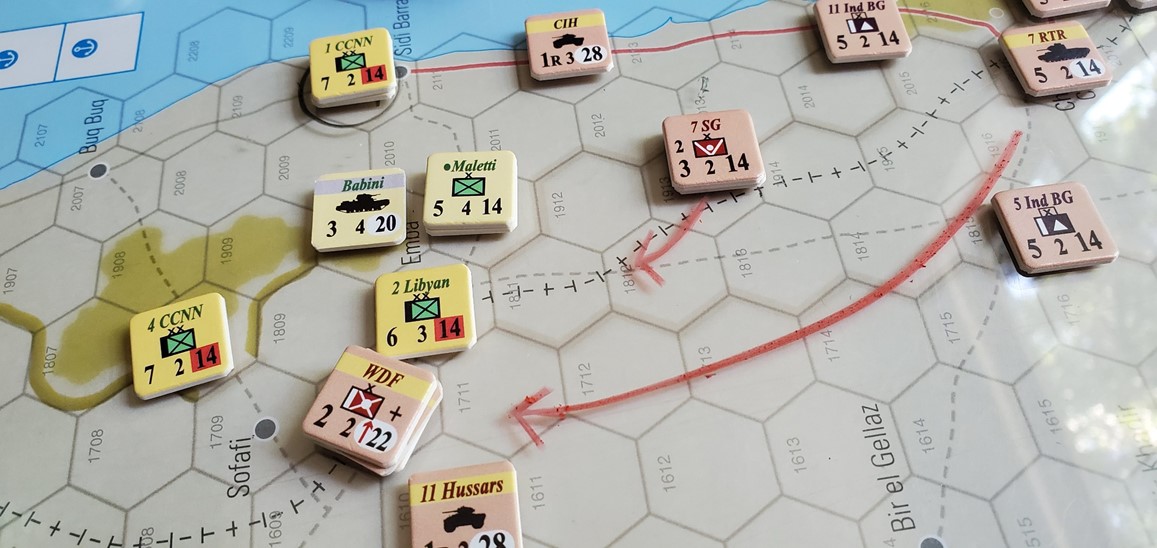REPOST::: Made some errors and fixed them –
Lets mosey along and see how combat works in its various forms for Desert Fox Deluxe.
Overruns
Overruns are a function of movement. A unit must be mechanised as per the definitions in rule 9.0 Noteworthy to keep in the front of your mind that unless the units is also rated as Mobile [an upwards red arrow] that the combat factor is halved going into the overrun.

Prior to my more complete understanding of this fact, I ran a combat as an overrun and we did not reduce it correctly and ran the combat at a 3:1 versus a 2:1. This attack pictured above is already a sketchy idea, which would be off the table at 2:1 [1.5 vs 1] odds. At 2:1 place on the CRT we drop down to the red bar below it at the #4 position. Roll a 1d6 [white die rolled a 5] and move the attack that many columns to the right. Ending up on the 9 column, instead of the 11 as in the picture..

So our result at 2:1 then shifted would have been Qw for the defender and no effect for the attacker. The 3:1 if had been that would be on the 11 column result is the same for the attacker but a Hw result for the defender.
The difference between Qw and Hw is pretty obvious. The stack of like rated units lose either ½ or a `/4 of their steps.
In this case with just one unit defending and one step in a morale category, a ¼ step loss is ignored. Whereas a ½ step would round up to a 1 step loss. Losses for a stack would group 2 rated morale, and 3 rated morale units and so on then take a ¼ or a half etc of each rating of morale.
The “m” means a morale check to stay in place or retreat 1-3 hexes. A “w” result is a disruption and mandatory retreat of 1-3 hexes.
In any case a ‘lucky result’ for the attacker. A result either side of the columns in question would have eliminated the Babini unit with the minimum 1step loss requirement [Xm]. Surely a disaster for the attacker!!
As an overrun this attack consumes no supply for the attacker or defender.
There are a number of other little nuances to overruns that make them useful, if you have the right units in the right place. But we can save that for another chat.
Regular Combat
Calculate Odds, allow for terrain, roll a 1d6 to ascertain what final column you are on then roll 1d6 for Attacker Defender result. Very straight forward but amazingly swingy for all combat really. You can move from 1-6 sets of odds. Here attacking at 8 factors attack 6. The Allies spend supply, and it is important to note though hard to see on the map that the escarpment blocks the ZOC into the attacker’s hex from Maletti. Otherwise the Allies would have to also arrange to attack his hex as well either with these same units or a different ‘soak off ‘attack. [EDIT Note, that terrain feature there is in fact a ridge. Which would have enforced a soak off attack. Escarpment are a yellow thicker line. This will suffice for the example]

Attacking into the clear at 1:1 they roll a 1d6 for ‘surprise shifts’ earning 4 shifts. They look on the 7 column and earn a m check. for the Libyan unit. They are in supply but did not spend supply to defend so they have a Morale of 4 [+1]. Its risky but they go for it.
With a 3 on the table for the result + 4 morale they roll a net 7 which means they are disrupted. Any morale roll over 6 is a disruption as a function of the a 1d6 roll+ your current net modified morale rate [ middle counter number].

Mobile Battle
Is for Mobile units, which are also mechanized units. They will have a little red arrow on them on the right. In the move phase you may only have used your RMA [Reaction move ¼ of your move points as a Mech unit]
Mobile Battle boils down to:
Only units with a red arrow are Mobile [per rule 9.0]. Those Mobile units are doubled in a Mobile Battle.
All defending mechanized units both mobile and non mobile are doubled in defense.
The description of this combat style sounds romantic, but I struggled with the wording. Pay close attention to rule 9.0, and understand the differences between, trucks, mechanized, tanks and mobile units. 14.9.2 makes the rule needless obtuse to my little mind.
Here is an example:

We will assume that the prior regular combat did not take place.
The WDF, the 4th and 7th Light armoured all join up to Mobile Battle and move just a ¼ of their movement points. They are attacking 2nd Libyan in the open. The Libyans formation is a foot unit.
The Allies spend a dump, which is withing 7 MMP [ mech movement points.] The 2nd Libyan do not spend a dump [ supply point]. The attack is a raw: 3:1 in clear. The Allies roll a 6 for their column shifts. This puts them on the 12 column, generating a Hr result. The Libyan Division loses ½ the steps and retreats 4-6 hexes. [Edit I think the total attacking factors makes it a raw 4:1, but end result is the same this time ! ]
Deliberate Combat
I can sum this up quickly. The attacker must pay extra supply but is allowed to add more than one arty unit. Movement is limited to your RMA in the prior phase; this is your “Monty Attack” mode. Only useful if you have a good lot of infantry adjacent or withing one hex and the spare supply dumps and Arty around to make it shift the odds for you [ Each arty unit moves the odds 1 column,] a very expensive proposition.